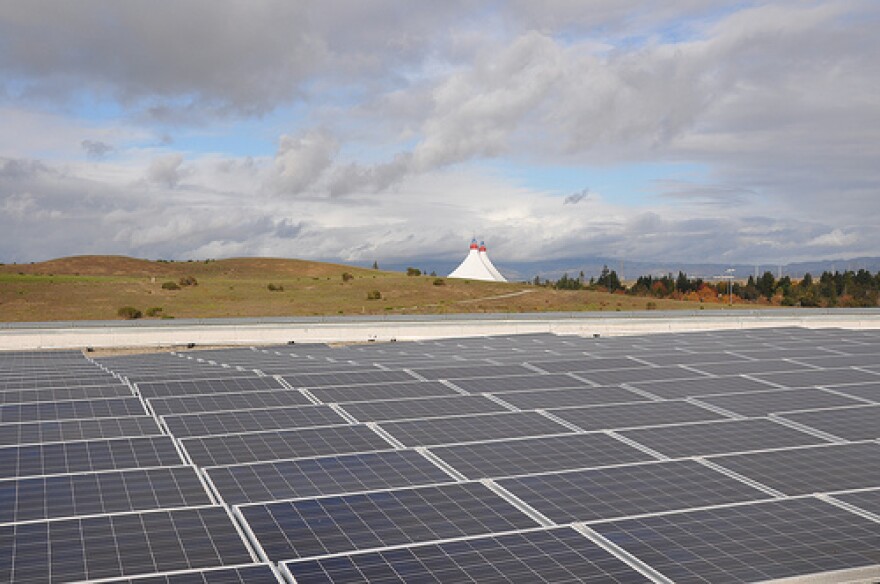Duke Energy is in discussion with large companies, including Google and Facebook, to use renewable energy to power new electricity needs in North Carolina. Companies can pay a premium and Duke will pour energy of the companies’ choice—solar or wind, for instance—into the grid to match the amount of power used. The new program sailed through the state utilities commission last month, but some environmental organizations question its potential. WFAE’s Ben Bradford joined Morning Edition host Kevin Kniestedt to explain.
KNIESTEDT: Ben, give our listener an example of how this works.
BRADFORD: Okay. Let’s say Google, expands one of its data warehouses out in Lenoir. Now it’s using more energy. Google’s a company that likes solar energy, so they opt into this program, and Duke generates the new energy specifically from solar—or they buy it from other solar companies.
KNIESTEDT: Power doesn’t get divided by source once it enters the electric grid, though. So, how’s this work?
BRADFORD: That’s true. Google’s actually getting a mix, like we all do, from nuclear, gas, coal, etc. But, Duke adds the amount of renewable energy that Google is buying to the grid. Jeff Brooks, who’s a Duke spokesperson, had a good explanation:
BROOKS: The physics of electricity: the kilowatt-hour typically takes the fastest path off the grid that it comes on the grid, so a lot of times the resource near you may be where your electricity comes from, but there’s no guarantee of that. Once that [renewable] energy is added to the grid, it is off-setting generation that would otherwise have to be generated to meet those customers’ needs, and that really is the point of the program.
BRADFORD: So, Google doesn’t get the energy itself, but the mix of electricity in the grid changes ever-so-slightly, adding in that renewable energy that Google paid for.
KNIESTEDT: What does that do to other ratepayers who aren’t in the program?
BRADFORD: Supposedly nothing. It’s a pilot program, just for large customers, slated to last three years. Whichever of those customers enter the contract—Google, Facebook, Walmart, whoever—they pay a higher rate for using the renewable energy, and everyone else continues paying the regular rate. That’s the contract that Duke’s hammered out with the state utility commission.
KNIESTEDT: So, the way the program is set up: large companies can opt-in to this program, get new energy from renewable sources they choose, and everyone else’s bills stay the same. Some environmental organizations have criticized it, though—why?
BRADFORD: Duke basically worked this deal out with the regulators before it was ever formally introduced. That meant the groups had less time to formally review it. So, that was more of a process complaint. The other big complaint comes from NCWARN, which is an environmental group whose stated mission is to push Duke into using more renewable energy. Here’s the group’s president, Jim Warren, talking about his concern:
WARREN: It appears there might be no new renewable energy coming forth or if there is some it would be coming very possibly from out of state—Texas and other places.
BRADFORD: Warren’s basic point is that, here in North Carolina, less than one percent of Duke’s power generation comes from renewable energy it has built. He says this program doesn’t encourage Duke to build more, because it lets the utility either buy more green energy from other companies or pump it in from out of state.
KNIESTEDT: Is he right?
BRADFORD: He’s right that the contract doesn’t force Duke to build more renewable energy. A spokesman for the utility says companies participating in the program can request their energy come from within the state, and if Duke can supply it, it will. So, yeah, it could come from out of state. That spokesman also makes a good point, though, that the further Duke has to send energy, the more expensive it is. So, at a certain point it might not make sense for them to send, say, wind power from Texas to North Carolina. It might make sense for them to just build new solar power here.
KNIESTEDT: You said renewables are a pretty small part of Duke’s mix of energy here. If that’s the case, why do this pilot program?
BRADFORD: I think companies asked for it, Google and Facebook, for instance. They’ve been very vocal about pursuing renewable energy, and Duke wants to continue to attract that kind of business because their servers consume huge amounts of energy. And, Walmart has announced a goal of having all of its energy come from renewable sources. So, Duke’s responding to that. And, at the same time, the company’s calling card in the state is low costs. Because they can separate the renewable costs from the rest of their customers, they can keep their calling card and cater to the Googles and Walmarts.


